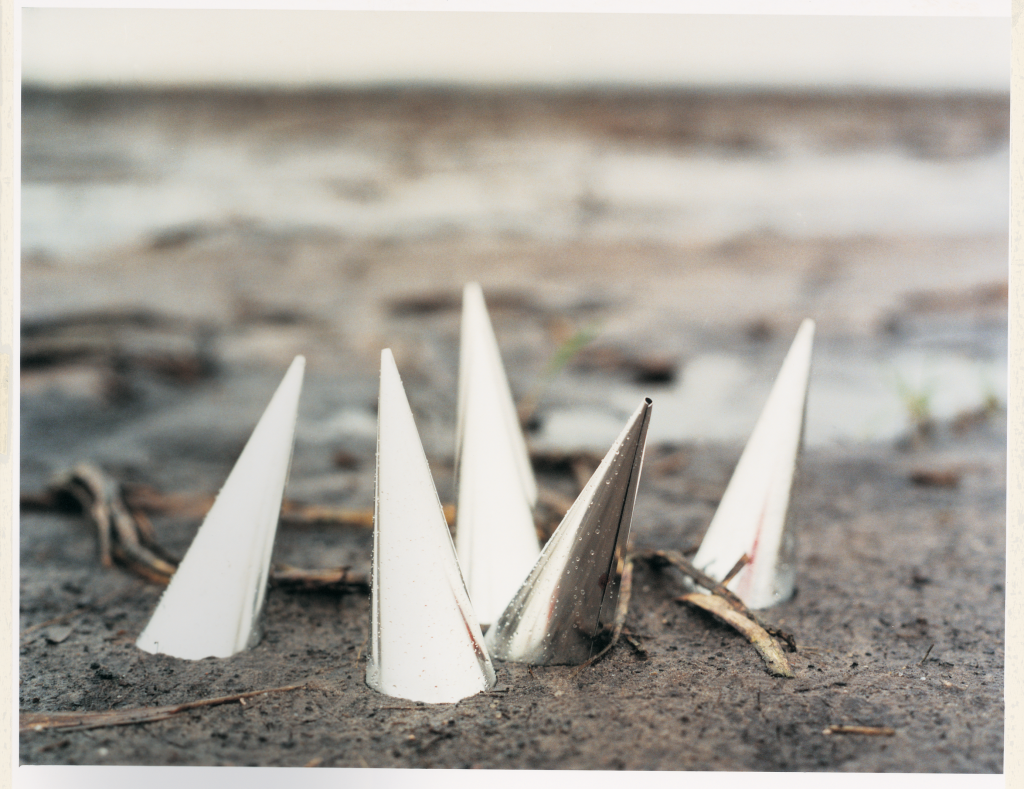Sian BonnellLarks in the Landscape

What are the distinctions between a landscape and the land, how does it change our perception of things if we consider them to be either in the landscape or on the land? The land, it seems, is something we work or walk upon, while the landscape is something we contemplate, paint, or photograph. Our relationship to the land is an active one, while our relationship to the landscape is essentially a passive one. If we walk in the landscape we participate in a romantic fantasy, Arcadia or Elysium are re-visited. The landscape is untouchable, it is distant, lying somewhere between percept and concept. When we consciously survey the landscape, our perception roves between what we observe and what we recollect of landscape archetypes.
In Sian Bonnell’s photographs, in which the landscape takes a secondary role, everyday objects, with prosaic domestic origins, are placed upon the land – often on some inauspicious site such as the corner of a field – and so become elevated into landscape features, offering a fantasy in which their relativity to that landscape, changes our perception of both the landscape and the object or objects. They bear no relationship to the land, as they have no relevance to it, we perceive them as being in the landscape, but not of the land. Our post-industrial urge to return to a mythical Albion is given a jolt by the raw mischievousness of these constructed landscape images, all our preconceptions of this genre are trashed by these anarchic subversions. Closer to Dada than Surrealism, their reinvention of the genre tests our forbearance, asks us to look at them with new eyes. The abiding power of photography is its power to transform reality while not disguising it, empowering us as viewers to adopt our own standpoint to its credible but nevertheless imperfect representations. When its credibility is stretched to the degree that Bonnell’s images are, the photograph asks for our intervention, asks for us to invest it with a new relevance.
Ever since primitive hunter-gatherers took to slash and burn cultivation, mankind has strived to impose himself on the land, to create a niche that accords with his needs, wishes or desires. In the 18th and 19th centuries, one of the expressions of this tendency was the creation of ‘follies’, man-made structures that had no useful purpose other than to mark man’s presence and to emphasise the importance of that presence. These follies would appear on a prominent hilltop or otherwise punctuate the skyline from some established viewing point or other. Sian Bonnell’s jelly moulds, pastry-cutters and pan-scourers, in imposing themselves on the landscape, seem similarly to mark woman’s presence there – their lack of relevance here, however, opens the gates for their dissolution into fantasy, and absorption into romantic myth. We can either perceive them as transitory and whimsical – there is no denying their humour – or we can see them as indicators of a new relationship between the domestic and the pastoral. If the pastoral is allowed to move into the domestic sphere through the agency of film, video or photography, or more traditionally, painting, then equally the domestic should be able to go out and inhabit the landscape, and while somewhat comical, the didacticism of these images cannot be denied. There is a crossover here between philosophical theory and pragmatic realism.
There are references in these images to both prehistoric and contemporary architecture and to the distinctions in man’s relationship to the landscape that those very different negotiations express. The Stone Circle expressed a synergy between man and his environment; the modern skyscraper is a symbol of domination through which man superimposes himself upon his environment. In the former, man tapped into nature’s diurnal and cosmic rhythms; in the latter, man expresses an arrogant indifference to those rhythms, and strangely enough, we can sense these contrasts in Bonnell’s overt simulations of these scenarios. In one image, her corned-beef tin skyscraper and in another, the columns of corned beef whose circle represents man’s dependence on nature, seem, on the surface, to be shot-through with whimsy but the merest consideration of their connotations reveals a penetrating critique of the dysfunctional ecology of contemporary life. Food or the utensils, vessels or containers associated with food, play a central role in Bonnell’s work but her re-contextualisation of this essentially domestic subject fundamentally re-invents it. Her black and white pinhole camera images of jelly-moulds, afford them a monumental mien, whereby they become a landscape instead of merely objects in a landscape while the background becomes merely the land. The aura and poignancy of these images can match any of Peter Emerson’s 19th century photographs of rural East Anglian scenes.
If we are awake to the visual puns which appear in Bonnell’s work, we begin to be aware of layers of meaning in these images. A shining example of this (brazen pun-upon-pun!) is her colour print of a glowing-pink ceramic jelly mould (that has the appearance of a jelly itself ), giving chromatic resonance to the Green Green Grass of Home. The radiance of the colour here is actually a reference to radiation and its implication in the irradiation of much food that currently appears on our supermarket shelves. We have come a long way from our hitherto pastoral origins, and the incongruence of this scene imparts, perhaps, an appropriate feeling of discomfort and apprehension. So images that might appear, initially at least, banal and whimsical, on reflection convey a message, which is laden with far more gravitas than their visual levity might suggest. There is more here than at first meets the eye.
